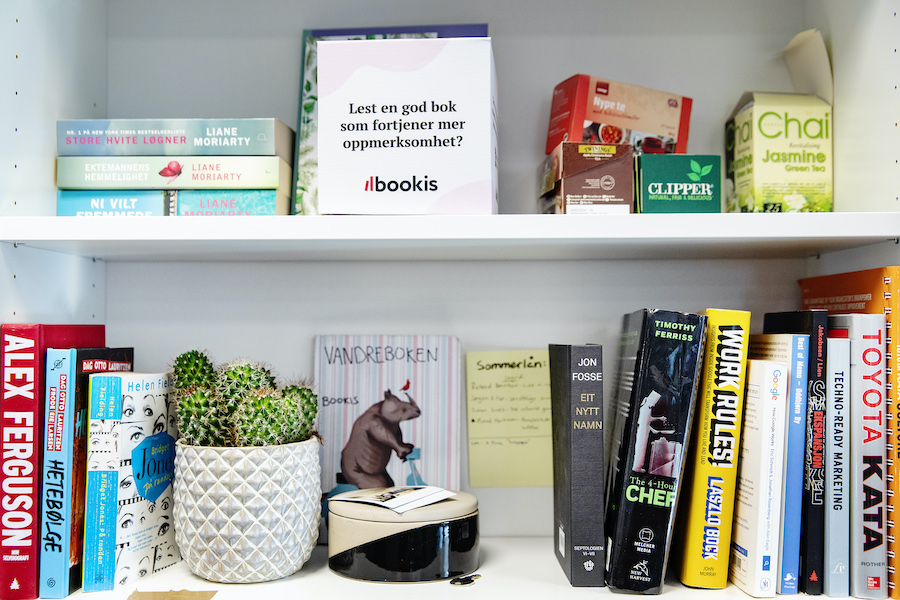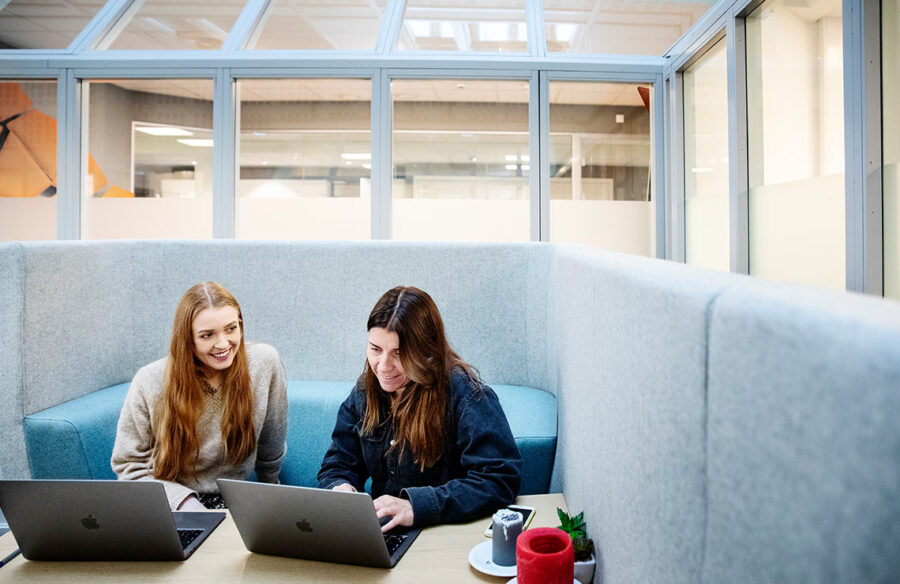Making used book sales painless

Lasse and Arne-Morten met in the armed forces, years before they started Bookis together.
Making used book sales painless
Bookis is a rare success story of literary entrepreneurship. In just a few years, the company’s online marketplace for used books has accumulated the widest selection of books in Norway, offering four times more Norwegian titles than its closest competitor.
With almost 300,000 users and more than a million titles, Bookis has established itself as an online treasure chest for book lovers in Norway and Sweden. On top of that, it has managed to shake up the old book publishing oligopoly. That doesn’t mean it’s achieved its goal, however – far from it.
But first, we need to go back to the beginning. Although the company wasn’t founded until 2017, we have to go all the way back to 2008 to find the true beginning of Bookis. More specifically, to the Norwegian Army Officer Candidate School in Indre Troms in northern Norway.
Because it was there, between the gun smoke and green army camouflage uniforms, that Lasse Brurok and Arne-Morten Willumsen first met.
A friendship that has lasted
“In the armed forces it doesn’t take long to get to know people on a deeper level. I think we both realised pretty quickly that this was a friendship that was going to last”, says Lasse.
The two young men served alongside each other for a couple of years before Arne-Morten packed his bags and moved to the United States to study finance. Lasse continued his career in the armed forces alongside working as a street artist. Even though they lived on different continents, their friendship remained strong.
When Arne-Morten returned to Norway a few years later, he got involved in a number of startups. In one of them he was responsible for the company accounts, and was tipped off about a book on Norwegian accounting rules. Because it was so expensive, he decided to find a used edition. That turned out to be more difficult than he expected.
“I came across sellers who never turned up at the agreed time, and there was no easy way to pay. It was shocking to see how difficult it was to buy a used book. In the States it was easy to buy used books via Amazon, but a similar service didn’t really exist in Norway.”
An idea began to form in Arne-Morten’s head. Recycling and the circular economy were more popular than ever before, and e-commerce in the Nordics was growing by as much as 20 percent annually. Could it really be that hard to set up a one-stop shop for used books?
“For people to even bother to sell a used book, the threshold has to be very low. No one is willing to spend a lot of time and energy on earning a hundred-krone note”, says Arne-Morten.
His idea gradually evolved, and in 2016 he shared it with Lasse over dinner. Before the evening was over, they had officially founded Bookis. Since that day they’ve never looked back.
In the beginning there was a lot of testing and failing. The first proper experiment involved turning a class of students at the BI Norwegian Business School into a concrete case. All the useful input they got from the students was used in the further development of Bookis.
“We used lean methodology and based our work on the build-measurelearn model. Through testing and failing, we gradually understood what worked and what didn’t”, says Lasse.
After a while they found themselves facing their biggest challenge so far: how would they get the books from the seller to the buyer?
Helthjem became a turning point
“The big turning point came when we called an acquaintance who’d recently got a job at Helthjem. They had just started to develop a new service called Me to You, that would make it super easy to send packages between private individuals. What an amazing stroke of luck!” says Arne-Morten.
Helthjem and Bookis developed their services in parallel, and launched them simultaneously just before Christmas in 2017. While everyone else slept during the dark winter nights, Helthjem’s couriers collected and delivered used books all over the country, from door to door.
“Getting the agreement in place with Helthjem was undoubtedly the most crucial factor to our later success. It’s like the stars were aligned”, says Lasse.
Since then, Bookis has worked continually on improving and simplifying its user experience. Integrating a function to enable customers to scan the barcode on the books they want to sell was a milestone. This allows Bookis to find all the information about the books and enter it into the system automatically.
To expand its selection, Bookis has also started selling new books at competitive prices. But it is still the used books that make up most of the inventory. The used books are also sold at a fixed price, which means that sellers don’t have to deal with hagglers.
It’s up to the buyer and seller to decide whether they want to meet in person or use Helthjem’s delivery service. If they choose Helthjem, the buyer pays the shipping charge.
“Sellers perceive us as a marketplace, while buyers perceive us as a regular online book store”, says Arne-Morten.
One thing that shocked Arne-Morten and Lasse when they entered the book industry was that Norwegian authors receive only 15 percent royalties on sales of their books while the publishers rake in the rest. On top of that, it is the publishers that own the copyrights. Arne-Morten and Lasse thought this was a really bad deal.
“We think the conditions for authors are bad enough to start with, and that they also deserve to earn money on the books that are sold on. So we developed a function for this. Buyers on Bookis can opt to add an amount of their choice as a royalty to the author when they buy a used book. So far we’ve collected more than NOK 700,000 for Norwegian authors”, says Lasse.
A good culture is most important
Product development and the business side are perhaps the two key aspects for many young entrepreneurs, but for Arne-Morten and Lasse, the top priority has been to build a good company culture. And they thank the armed forces for that. They describe the Norwegian Army Officer Candidate School as a kind of crash course in leadership.
“Our philosophy is simple: look after the staff and solve the task – in that order. Our goal has been to nurture a good work environment with a high level of psychological safety. Without a healthy and positive culture based on trust, we will never succeed”, says Lasse.
In a safe space, there’s nothing dangerous or frightening, and that includes talking about your own mistakes or showing your vulnerability.
“We often discuss our own mistakes and what we have learned from them”
“Lasse and I have always been good at challenging each other, even in front of colleagues. But it’s done out of love, and out of a shared desire to succeed. And we often discuss our own mistakes and what we have learned from them. More leaders should be better at showing that they’re just humans, too”, says Arne-Morten.
And no one in Bookis gets applause for working long hours.
“We want people to have a healthy life-work balance. We come and go at normal hours, and when we leave work, we turn of all the job-related notifications on our phones. There’s nothing cool about working yourself into the ground or sending e-mails to everyone at all hours”, says Lasse.
They’ve also introduced meeting-free Wednesdays and are happy if colleagues don’t reply to e-mails or messages on Slack during the workday. “That just
means that they’re focusing on their tasks and are not letting themselves be interrupted by all those time stealers”, says Lasse.
And it seems that both the business model and their leadership philosophy has worked; after only four years, the arrows are pointing upwards for Bookis. But where do they go from here?
“We’ll keep banging away, and we will definitely work closer with authors in the future. We’re not quite ready to reveal our specific plans just yet. The only thing I can say for sure is that it will be totally cool! And that Bookis will be a well-known name on a lot more people’s lips”, says Arne-Morten.
This is Bookis
Norwegian launch: December 2017.
Swedish launch: September 2020.
Number of users: 285,000 (70,000 in Sweden).
Number of employees: 26.
- Bookis offers a four times larger assortment of Norwegian titles than its competitors.
- Offers a mix of fiction and non-fiction titles.
- The first in the world to launch a royalty program for used books.
- Aims to expand into new markets.
- Has a revenue of over 50 million NOK in 2021.
- Schibsted made an initial investment in Bookis in 2019, and today owns 29.3 per cent of the company.

Linda Christine Strande
Communications Manager
Years in Schibsted: 3
Protocols, tigers and unicorns

Protocols, tigers and unicorns
2021 is a time of change for entrepreneurs raising venture capital, and for the firms providing it. For founders, there has never been a better moment to start a company and seek funding. Dan Ouchterlony, EVP Financial Services and Ventures, looks into an exciting future.
Venture capital is booming. In the third quarter of 2021, a whopping 158.2 billion USD was invested into start-ups at various stages, according to CB Insights. This is more than double the investment compared to the third quarter 2020 (which itself was a strong quarter!) and the highest number on record for a single quarter.
The driver was the volume of large rounds, totalling 409 investments of more than 100 million USD, up from 173 in Q3 2020. However, at the end of the funnel, exits have only increased 13 percent in 2021, as compared to 2020. Thus, an increasing amount of wealth is tied up in start-ups.
This prompts many questions. What are the driving trends in the industry, and why is interest booming? Who are the movers and shakers? And what is happening on the fringes? Is the rising tide lifting all boats, or are some players at risk of losing out?
Masayoshi Yasumoto was bullied as a child. Despite being third generation Japanese, he was considered ethnically different. In his adolescence he agonised over his identity to the extent that he seriously contemplated taking his own life. Today he claims, somewhat credibly, that he is the Rothschild of the Internet era. But you know him as Masa-san – the CEO of Softbank and chairman of The Vision Fund, the world’s largest venture capital fund.
Masa and The Vision Fund came blazing on the venture capital scene on 20 May 2017, with the announcement that they had closed 93 billion USD of commitments to the fund. Compared to the 153 billion USD of venture capital invested in 2016, this was a staggering number by all accounts. By September 2019, all the funds were deployed, except a small reserve, and venture capital was changed at its core.
The Vision Fund changed the game by being more aggressive than other venture capital firms, both in terms of how much capital they deployed into their investments and by threatening to fund rivals. Established venture capital funds lost out on deals, as Masa-san was willing to raise valuations, and effectively bought his way into deals using both carrot and whip. Seen as a king maker in the segments they entered,founders and CEOs jostled to stay behind, rather than in front of, what Dara Khosrowshahi, Uber’s CEO, famously called “the capital cannon”. What happens if Softbank funds my rival, wasn’t a rhetorical question.
The canon has not reloaded
Softbank and The Vision Fund also played a different game in the public arena. Whereas many established venture capital players relied on building relations, understated communication, and thought leadership in their industries, Masa-san went on stage with slogans like “happiness for everyone” and slides with pastel-coloured unicorns and golden geese.
The Vision Fund’s capital cannon has not been able to reload, however. And due to the poor financial results (so far) of Vision Fund 1, Vision Fund 2 has shrunk dramatically in comparison. With the aim to raise 108 billion USD, the fund has only raised 30 billion USD to date, all of which is committed from its owners at Softbank.
Was it then a historical blip on the radar? Some of what happened might be told as a cautionary tale for the next generation of venture capitalists during fireside chats. But one thing is for certain. Masa-san is not finished. He is not a stranger to failure after losing some 70 billion USD of personal wealth in the dotcom crash, and rising taller from adversity, as exemplified by changing his family name from their Japanese-assumed name of Yasumoto back to his family’s original Korean name Masa Son.
One thing that seems to have permanently changed in the wake of The Vision Fund is the speed of execution in large deals. But today, the velocity of deal making is no longer the hallmark of the “Unicorn Hunter”, but that of the “Tiger”.
But today, the velocity of deal making is no longer the hallmark of the “Unicorn Hunter”, but that of the “Tiger”.
Tiger Management was one of the largest hedge funds of the 1990s. After a bout of poor performance, it closed in 2000. Out of the ashes of the fallen fund, some 30 young managers in the team were staked to start their own hedge funds. One of them was Tiger Global Management – the Tiger that we know and talk about in the venture capital business today.
Tiger is, so far during 2021, closing about 1.2 deals per business day. This speed is unusual even for the predator: according to Crunchbase, 240 investments have been made as of 11 October 2021, up from 80 deals during the whole of 2020, and 86 deals in 2019, during the same period. In other words, Tiger is running three times their already high speed.
Pundits are commenting that Tiger is “indexing” the venture capital market, in a move characteristic of a hedge fund. Not a cannon perhaps, but a machine gun. The theory goes that if they spread their bets widely enough, they will hit enough success cases to generate returns.
What does this mean? First, let’s look back. The venture capital business is traditionally based on long-term relationships, which in and of itself means investing a lot of time per deal and trying to add value after the deal is done. It’s a model taken “to the next level” by Andreesseen Horowitz, who famously built the largest support staff in the business and financed it by forfeiting their own management fee. Despite Tiger’s extremely big staff, doing and supporting 240 deals in three quarters is just not sustainable on this conventional model. So how does Tiger do it?
Tiger does not build relationships
They do it by effectively employing the opposite of the conventional wisdom. Tiger does not build relationships in advance of sending term sheets. Tiger does not want a seat on the board. Tiger does not want to do heavy due diligence. And Tiger does not try to support you operationally after the deal. This indexing of bets has already happened to some extent in the earlier stages, where organisations such as Ycombinator and 500 Start-ups have tried to spread their bets very widely by speeding up investing. But with the sheer amount of early-stage rounds happening, the index will never be even close to complete. Tiger, on the other hand, has a real shot in the later stages.
The result of Tiger’s approach for founders is better, faster and cheaper capital, according to Everett Randle of Founders Fund. Start-up founders can spend less time raising funds and can for good and for bad, take capital without giving up control. This is attractive for many, and only the biggest, most successful venture brands will survive long-term with the established relationship model, according to Everett. The mid-sized firms will be squeezed by Tigers and the like, who are forging ahead with extreme conviction.
For venture capital this means many more people want to get involved
Another phenomenon on the rise, both in general and especially among the young, is decentralised finance. Technical terms such as blockchains, crypto currency and non-fungible tokens (NFT) are becoming mainstream. There are two things going on at the same time: First, access to and interest in capital markets are on the rise generally, boosted by players such as Robinhood and the get-rich-quick FOMO in the longest of bull markets. Second, entirely new technologies that decentralise and democratise finance – defi in short – are on the rise. One example is investor-entrepreneur from generation Z, Jacob Clearhout, left his firm to “do a start-up” at the intersection of VC and defi. In a fantasy football game for start-up shares called Visionrare, fake shares are minted as NFTs, sold for five USD each, and then made investable in a game of I-told-you-so.
For venture capital this means many more people want to get involved, both as venture investors, builders, speculators and commentators. One particularly interesting topic is the attack on the existing power structures in venture capital. As an industry that typically builds on apprenticeship, personal networks and significant personal wealth, it is somewhat uncomfortable to have young talent discuss tips for “breaking into VC”, “discrimination of non-white founders”, and why it is time to “ban the warm introduction”. According to Del Johnson, who launched the proposed embargo, the network-based approach of personal introductions is not only anti-founder and discriminatory, but even worse, it leads to subpar performance. Why? Because you miss the opportunities outside your network.
What is even more uncomfortable for many are defi structures that emulate and disrupt the venture capital firm itself. On the bleeding edge of development there are venture capital initiatives on the blockchain, structured as decentralised autonomous organisations (DAOs). Either these new structures appear for a special purpose, such as when the digital artist Pplpleasr auctioned off one of his works. And the winning bid was placed by some 30 individuals who organised on social media, gathered the funds, and formed a joint investment DAO in the matter of days. Incorporating an investment firm is a much slower process.
Votings are held in public
Pleasr-DAO has since invested in art by Snowden and Wu-Tang Clan’s album Once Upon a Time in Shaolin, which they bought from the US Department of Justice, who in turn seized it from original buyer, pharma profiteer Martin Shkreli.
Another type of DAO can be a more general “VC on the blockchain” structure, such as when Singaporian cryptoexchange Bybit launched the 540 million USD investment vehicle Bit-DAO in September 2021, with external funding from Peter Thiel and Founders Fund among others. To be clear, this is a half billion-dollar VC firm in a protocol where partnership meetings (voting) are held in public, investment proposals are openly scrutinised (in a forum) and the governance model itself is defined by code.
The idea is not new. In April 2016, the first DAO named “The DAO” was launched, raising about 150 million USD worth of crypto currency from more than 11,000 investors through crowdfunding. At the time around 14 percent of all Ether in issue was owned by The DAO, with plans to become a fully decentralised venture fund. However, the code running this particular firm was flawed, and after losing a third of the capital to a hack, The DAO was delisted, and the project was disbanded. To recoup the losses, the actual blockchain underpinning The DAO was split in two, and the transactions were annulled. If not for the false start, many believe DAOs would have had a much more prominent role today.
As if this wasn’t enough, traditional venture capitalists also face a new generation of investors who are starting out their careers with a new focus and modus operandi, which just might be the future.
Meagan Loyst, investor at Lerer Hippeau is the founder of Gen Z VCs, a network of more than 10,000 who identify with the community of investors and entrepreneurs born after 1995. On her Medium page she published that the number one trend this group is interested in is the creator economy (Roblox, TikTok, UGC, etc.).
Their takeaway is that people see the path to becoming a creator as more institutionalised, and from a young age. Is the same happening to VC in general? The lines between entrepreneurship, investing and creating are certainly blurring. Many entrepreneurs are also angel investors and vice versa. Young VCs are obviously not afraid to network, entirely on the outside of the traditional pipelines of the firms; they are not afraid to make their voices heard; and topics of sustainability, inclusion and equal opportunity are on the rise.
If you are a venture capital firm today, your cosy corner of the market is under attack from many sides: Hedge funds trying to index your asset class “from above”, angels and young VCs banding together online, and blockchain tinkerers trying to democratise your privileged access “from below”. And there you are stuck in the middle. What will you do?
You could adapt and beat Tiger at their own game, like Sequoia China seems to have done. While Tiger takes the media headlines, the semi-independent Chinese arm of industry titan Sequoia made ten more deals in Q3 2021 than Tiger did, according to CB Insights. Does this mean entrepreneurs who take Sequoia China on board as investors will not get the gold standard support of Sequoia?
Only time will tell. In late October 2021 Sequoia announced they will go even more in Tiger’s direction by dropping the traditional a 10-year fund-circle, staying post IPO in the most promising companies. In practice they are becoming a hedge fund.
You could also double down on the current strategy, like it seems Andreesseen Horowitz has done in the crypto arena, by building out its investment and
support teams with roles such as crypto counsel, protocol specialist and crypto network operations. At one point, A16Z Crypto recruited so fast, it became a Twitter meme. According to the Information staff has almost tripled in four years.
Who will succeed? Will Tiger be able to show good returns on their massive bet and reload their capital machine gun? Can the established firms catch up? Or will doubling down on the proven approach work best? Over time, might the coming generation build new kinds of protocols and networks, making the firm itself obsolete?
2021 is a time of change for venture capital, and for founders there has never been a better time to start a company and raise capital.
Schibsted Ventures
- Schibsted Ventures represents corporate venture capital (CVC), a segment of venture investing that has been stable at 16–17 percent of the market, both during the more stable period in 2018–2020 and the explosive growth of 2021. We compete for the best investments using venture capital plus the potential benefits of the corporation’s assets, resources and insights.
- Our objective is to generate returns, but equally important is to speed up execution on our vision by supporting entrepreneurs who share our view of the future. This is a version of A16Z’s hands-on strategy if you will, but in another setting.
- Top CVC investors in Q3 2021 were Coinbase Ventures, Salesforce Ventures and Google Ventures according to CB Insights.
- Are you an entrepreneur in the Nordics, passionate about themes such as transparency, sustainability and empowering people in general? Reach out!

Dan Ouchterlony
EVP Financial Services & Ventures
Years in Schibsted: 16
Uncertainty is like driving on an ice patch

Amy Webb and her Future Today Institute team has helped Schibsted isolate six trends that the company needs to lean into. Photo: Emil Wesolowski
“Uncertainty is like driving on an ice patch”
How do you face the uncertainties of the future without a crystal ball? You analyse data and you prepare as best as you can. In the Horizon project, Schibsted is doing just this together with the Future Today Institute and its founder Amy Webb.
The Horizon corporate strategy project was created with the purpose of creating a common understanding of mega-trends shaping Schibsted future in five to ten years and rehearsing multiple futures through plausible scenarios. The project was created by Schibsted together with Tinius Trust/Blommenholm Industrier and the Future Today Institute, to make Schibsted better equipped to succeed – regardless of how the future develops.
Futurist Amy Webb and her team at Future Today Institute have worked closely with Schibsted’s Anders Grimstad and Zuzanna Zyglado-Stenberg to create a plan for whatever the future may hold.
Webb explains this work as looking for signal data early, thinking about what that might mean and starting to model alternative futures that describe next-order actions.
Slowing down the process of change
“There’s an analogy that I like to use to describe what this process is like. I’m originally from Chicago in the United States, where there is a ton of snow, lots of ice, lots of wind – it gets very, very cold”, Webb says, something her hometown has in common with the Nordics.
In both places, anyone with a drivers license needs to learn to drive on ice. She says this moment that we’re living through, with uncertainties in business, regulations, environment and regarding the pandemic, is very much like being in a car sliding around on ice.
“When you’re driving, and you’re hitting an icy patch, at that point, your limbic system starts to take over. You get really nervous and you start a lot of super-fast, haphazard decisions.”
She explains that your brain believes that if you slam your foot on the break right then, the car will stop. But that’s not the case. Slamming your foot on the break will just cause greater problems. So what do you do instead?
“You’re supposed to steer your car into the direction that you’re sliding. That feels wrong in the moment, but as you know, if you keep your eyes on the road further ahead, what steering into the slide does is it slows down the process of change.”
That’s what we should be doing right now, in business as well, even though it feels wrong, she says. We should be leaning into uncertainty.
“I think it’s all about recognising those uncertainties but also exploring the white space. Where are all the possibilities for Schibsted to grow in ways that you just haven’t thought of before?”
Created clusters of trends
Starting this project, the Schibsted team, together with FTI, created baseline futures based on interviews with the top stakeholders and leaders. Ironing out where they agree and where they disagree on what the world will look like in five to ten years allows them to see where our uncertainties lie. From there, FTI was able to look into their data to see which trends coincide with Schibsted’s interests (look into the six overarching trends here).
With trend clusters in place, FTI is now ready to create future scenarios, being the next milestone in the Horizon project. A key thing to bear in mind when looking into the future, though, is that it’s not as far away as you might think. Preparing for tomorrow means acting now, creating a plan for next year with a ten-year perspective, or even six months ahead, but always with a long-term perspective in mind..
“There’s already a case where Schibsted saw the challenges of the future and acted in time to change and grow”, says project co-lead Zuzanna Zygadlo-Stenberg, referring to establishing online classified at the beginning of 2000s with Finn.no. At the time, Schibsted was a media company faced with the uncertainty of what what the future promise of the internet might hold.
“We managed to adapt, build marketplaces and take a position in a new space and become profitable. Understanding the great forces, how to use them to our advantage and create growth”, Zygadlo-Stenberg concludes.

Camilla Buch
Advisor Editorial Content
Years in Schibsted: 1.5
We will only invest in companies aligned with our values

“We will only invest in companies aligned with our values”
He has billions of NOK to spend to help Schibsted grow even more. Andrew Kvålseth is the new Chief Investment Officer, hired to build on the success of Schibsted’s prior successful investments.
Schibsted is a growth company, it has already reinvented itself so many times through investments, and that’s what we need to continue to do to be successful over the long-term.”
Andrew only just began in August 2021 and his role is new. But Schibsted’s has a strong history of making successful investments. From printing, to news, to digital media. And not least, Schibsted brought classified ads online and made a series of international marketplace investments, which eventually became Adevinta, a company worth more than 150 billion NOK.
Now, some of the capital from these successful investments needs to be redeployed to create a strong portfolio to diversify and drive the future growth of Schibsted and – not least – to support its underlying mission of empowering people in their daily lives. Andrew will work with Schibsted Ventures, and all other investment teams across the company, to support this mission.
News media a core part
“There are many attractive opportunities for a company like Schibsted. In my view, news media is a core part of our purpose, especially considering what is happening around the world – trustworthy news are more important than ever. Schibsted’s DNA is news and we have done better than mostAs an example, he mentions the NYT who is very proud of its seven million paying subscribers, and has the whole English-speaking world as its market. Compared to this, Schibsted is doing very well with more than one million subscribers.
“Still, there is so much potential. You can either look at the media industry as something fixed – or be part of innovating it. We choose the latter.”
News might be core – but from an investor’s point of view, marketplaces is a much broader arena and the other areas where Schibsted operates today is of course also on the agenda: like financial services, e-commerce and distribution. In all these areas, Schibsted has experience and know how to grow and scale.
But whatever area Andrew and his team will look into, Schibsted vision and mission are key.
“It’s our guard rail and boundary. We will only invest in companies that are aligned with our values.”
In Schibsted, there is always this question of which language to speak when you meet people. We have quite a few people from different countries in the organisation and their names don’t always help. Kvålseth is very Norwegian – and yes, Andrew was born in Trondheim. But the family left for the US when he was only one year old. He has been back to Scandinavia on several other jobs in the past, and he’s been working in the US, Asia and the Middle East. He has, of course, had a good knowledge of Schibsted through his line of work – but also through some of our services.
“I use Finn a lot – and I actually read Aftenposten daily to learn more Norwegian, and stay informed.”
A complex company
Now he and his Norwegian wife have ended up back in Norway, after many years in Asia and the Middle East. While they enjoyed the time abroad, they started to think about where they wanted their children to grow up and have a more permanent “home”.
“We were in a position where we looked at the globe and asked ourselves where we wanted to live. Choosing the Nordics was a conscious decision – with its values, equality, open society and healthy lifestyle.”
So, many things with joining Schibsted were a match – even though he has learnt that Schibsted with all its different brands and divisions is a much more complex company than he first believed.
“From the outside, I was always impressed with Schibsted and the incredible success they have had at innovating, investing and reinvesting themselves. But it’s like I ate this awesome sausage, and then I saw how it’s made – it’s really complicated with so many brands and businesses. But that is also part of what makes it work so well.”

Ann Axelsson
Senior Product Manager, Strategic Communications
Years in Schibsted: 23
Six battles news media must win

Six battles news media must win
With news brands in strong positions and more than one million digital subscribers, it’s time to take on a new ambitious strategy for Schibsted’s news media. Siv Juvik Tveitnes, Head of the media division in Schibsted, defines six must-win battles on the road ahead.
For the last few decades, the media industry has faced enormous challenges, struggling to find its way in a new digital landscape. We have undergone – and are continuing to undergo – a digital transformation. The way in which people consume news and content has radically changed. Information flows are increasing exponentially, and our business models and ways of working have changed in step with new trends. This has all been very challenging, and like many others, Schibsted has made many difficult decisions along the way. It’s been a time of reorganisations, cost cutting, mergers and concern about the future.
But today the picture looks different in Schibsted. All the work we put in, all the reorganisations we initiated, along with the increased pace of innovation and development, have borne fruit. We have achieved our goal of sustainable digital media. In September 2021, we reached one million digital subscribers. And the willingness to pay for news is growing in both Norway and Sweden.
A strong digital trend during the pandemic has also revealed a future in which digital revenues grow more than print revenues fall. So, as we move forward, we are able to focus on growth. And to operationalise this ambition, we have defined six must-win battles.
1. Strengthen our journalistic positions
Our news media brands have significant growth potential, but this requires us to invest and innovate. The competition is hard, and our users have high demands when it comes to quality, credibility and user experience. We must continue to strengthen their loyalty and confidence in us.
At the same time, our brands hold different positions. For instance, for VG and Aftonbladet, it’s about being the most important news destination. While Aftenposten aims for a more explanatory role, and Svenska Dagbladet strives to deliver on a smart news experience. Bergens Tidende and Stavanger Aftenblad are investing a lot of resources in strengthening their respective regional positions, just as our local news brands aim to strengthen their local positions. E24 has the position as Norway’s biggest online destination for financial and business news. And the news service Omni’s desired position is to be number one among the forward-leaning news consumers in Sweden.
The common denominator is that we all depend on a visionary product strategy to stay ahead when it comes to meeting the needs of tomorrow’s media users – at the same time as we meet their needs today.
As a response to this, our product organisation has developed a vision, one that is spot on: “To be a natural part of everyone’s daily habits”.
2. Challenge for new positions
We have significant potential when it comes to creating new media products and services that can bring even more value to people’s lives. The media landscape is characterised by consolidations, and these create opportunities to explore new products and revenues – both inside and outside our core business.
Our investment in the podcast platform Podme is one example of a non-traditional media product we are focusing on in several countries. It has moved from being a venture investment in Schibsted to becoming part of our core business. We will pursue our interest in companies and brands where we believe we can be good owners. It’s natural for us to focus initially on the Nordic region. But in Schibsted anything is possible…
3. Grow subscription with smarter offerings
The level of willingness to pay for journalism is high in Norway and Sweden. In these countries we have been pioneers in the market. We have been driving this trend through our high-quality journalism, as well as our continual work to add value to our products and the user journey. The growth potential remains great in terms of winning more customers and developing smarter offerings across our brands. Moving forward, we will grow in three ways:
Through our existing brands, as we have done in the past.
Through a bigger and broader portfolio of brands, such as Podme and our acquisition of the outdoor recreation magazine Fri Flyt. More investments will follow.
Through a more interwoven portfolio. We must create seamless user journeys that meet people’s needs. We will continue to experiment in bundling products. The initiative in E24 is a good example of how we can reach a much wider audience and broaden our content, by offering E24 along with our other brands.
4. Reinforce our premium advertising position
Competition in the advertising market is fierce. The pandemic posed a major challenge for us and for advertisers, but the outlook is much brighter, and activity in the market is picking up. We believe that we still are – and will continue to be – a strong alternative to the global giants, and we will continue to invest in – and strengthen – our current premium advertising position. To strengthen our position, we must have control of the regulatory changes that will affect how we and others, not least the tech giants, run our advertising businesses.
We must also invest in first-hand, high-quality data, which we obtain by increasing the number of logged-in users. If we succeed in that, we will continue to have a major competitive advantage. Developing our effect metrics, exploring e-commerce opportunities, and growing our content marketing business are other areas that will be particularly important in the time ahead.
5. Grow our people and attract talent
The competition for talent is intense but extremely important. We must be in a position where we can attract the best people while developing those we already have. We are now entering new and unexplored territory, where hybrid jobs and more flexibility will be the norm. We don’t know how this will affect collaboration, culture and loyalty. Still, we must have a clear plan in place for recruitment, competence development, leadership development and career planning.
Diversity and inclusion are also high on our agenda, in the whole of Schibsted and across society. We have improvement potential that we take very seriously.
6. Improve our data and tech foundation
Our growth strategy is completely dependent on us using data in more sophisticated ways – and continually striving to improve the user experience. This applies to advertising, subscriptions and product development for all our brands, both individually and across. We also see a lot of untapped potential in the use of technology such as artificial intelligence.
It’s vital that we succeed in getting as many people as possible to log into our products. Access to data on our users is vital for creating even more relevant new products, such as through personalisation. People use our products in different ways, and we need to take this into account.
Our common platforms, the editorial, subscription and advertising platforms, provide us with a solid competitive advantage and ability to scale. Continuous development of these platforms is also vital to achieve further growth.
The ability to finally stand strong and look ahead with another, ambitious perspective serves as a powerful source of motivation for all of us working within News Media in Schibsted. We do have world-class news media brands. We have an amazing organisation of talented people who help ensure that we can continually develop quality products and services, ones that meet our users’ needs.
The fact that our strong news media brands also are part of a larger Schibsted family, with a solid financial position that is willing to invest – not only within our core areas, but also to look at opportunities beyond that – gives us the best starting point and the best conditions we’ve had for many years to reach new ambitions and new heights.
Most importantly this gives us the muscle power to pursue our societal mission to have a broad reach and to strengthen democracy through free and independent high-quality journalism. Something that is more important than ever.

Siv Juvik Tveitnes
EVP News Media
Years in Schibsted: 15
Six drivers for change

Six drivers for change
We live in a new climate in which disruption is normal. Together with Amy Webb and the Future Today Institute, Schibsted has identified six drivers for change that will specifically influence our future.
Changing demographics and society
Significant societal and cultural change will shift the face of the consumer and the cultural environment. Migration, combined with falling birth rates, are changing the Nordics. Immigration, while necessary to sustain population levels, is challenging countries to fully integrate these new residents. Language barriers are growing.
In addition, younger generations are influencing more purchase decisions and setting new expectations for experiences that seamlessly flow from physical to digital and back. Gen Z is entering the workforce with a weaker economic outlook and concerns about their ability to own their home. This will impact consumption patterns and workplace cultures.
Changing consumer expectations may force Nordic companies to evaluate their business models across the core industries, while the changing political environment may shift regulation in the markets where they operate.
Significant trends: New generations of consumers, increased migration, globally eroding trust in media, sustainability.
Artificial intelligence advancements
Artificial intelligence is changing the value we can extract from data and the nature of our interactions. AI represents the third era of computing and is used across most industries. The convergence of ground-breaking research, business use cases, the explosive growth of data, and improvements in computing power and storage are enabling advances in AI. The global artificial intelligence market is expected to grow at a CAGR of 42.2 percent from 2021 to 2027.
AI represents significant opportunity and serious risk in the forms of automating content versioning, deploying new forms of media and entertainment, developing shared efficiencies across portfolio brands and the potential spread of misinformation. AI advancements may create new content opportunities, but it also forces companies to determine how to address a growing category of experiences that aren’t “real” or “fake”, but generated, manipulated or synthetic. AI greatly impacts the future of media.
Significant trends: GPT-3 (advanced language models) evolution, synthetic media applications, new realities (AR/VR/XR), algorithm marketplaces.
Move to distributed consumption
From cars to clothes to entertainment, consumers are turning to access over ownership. Distributed consumption models are shifting the power dynamics in the relationship between companies and customers. As consumers move away from ownership of assets, subscription models enable them to buy access but at a cost; when subscriptions lapse, users don’t retain anything.
Governments and consumers are driving adoption of the circular economy. Beyond sustainability, these models can drive deeper engagement with customers and help a brand gain greater control over the resale market for its products. Significant growth and investment in the area moving products away from classified-like marketplaces and into branded resale experiences. Fractional ownership creates opportunities for affordable stakes in assets that would otherwise be out of reach for many, but these markets are driving asset prices higher as they spark speculative investing.
Significant trends: subscription models/D2C economy, subscription models for news, circular economy, fractional ownership.
Financial, contract and verification technologies
The basis for trust in interactions is shifting –including how we authenticate who we are and verify what we buy. Technology is facilitating trusted interactions through decentralisation and reducing the trust required between parties. This shifts trust to the technology structure itself. Trust in brands may only come if they carry a verification seal backed by data we can inspect. Consumers will expect companies to adopt more of these technologies to reduce friction and make transparent information about product origin.
Despite the growth in platforms and apps, the promise of decentralisation is not being realised globally. Services are beginning to use geo-blocking to limit access and prevent conflicts with sanctioned countries. A digital divide is growing — who you are and where you are dictates what technology you can use.
By shaping the future of interactions, these technologies create opportunities for new services along with significant early-mover advantages due to the investment and network effects required.
Significant trends: Purpose-built blockchains, smart contracts, decentralised social networks, verification and provenance.
Optimising decisions and discovery
Algorithms are changing the way we search for information, make decisions, and even discover new sources and ideas. New technologies and trends will impact how consumers find media and services — and how they behave once that happens.
Changes in decision-making and discovery could disintermediate companies like Schibsted from their customers. This is an area of vulnerability for Schibsted – and Scandinavia in general – when compared with global tech players who are driving innovation in these trends. At the same time, there are meaningful opportunities for anyone who can successfully identify a new product.
Search and discovery define the first steps in a customer journey. As customers adopt new ways of finding information and making decisions, gatekeepers will have greater influence on that path and may exclude other brands as sources or their sites as destinations.
Significant trends: Natural language search, non-text search, personalised versioning in news, one-to-few publishing.
Growth of enabling technologies
Digital infrastructure that demonstrates an understanding of the customer and eliminates friction is shifting expectations. Enabling technologies drive radical innovation and new capabilities. Circuit boards, communications satellites and the internet are three key enabling technologies that gave rise to computers and smartphones, the entertainment industry and three of the most valuable companies in the world (Apple, Microsoft and Amazon).
In the coming decade, a host of new enabling technologies will shift the consumer and enterprise markets once again, as 5G and 6G networks are deployed, supply chains and retail operations are digitised and climate change forces the fast adoption of smart grid management.
These technologies create foundational capabilities for all digital businesses, but tech players may have a first-mover advantage and ultimately disintermediate smaller players from customers.
Significant trends: Emerging consumer devices, next-gen wireless, automated logistics, smart grid management.
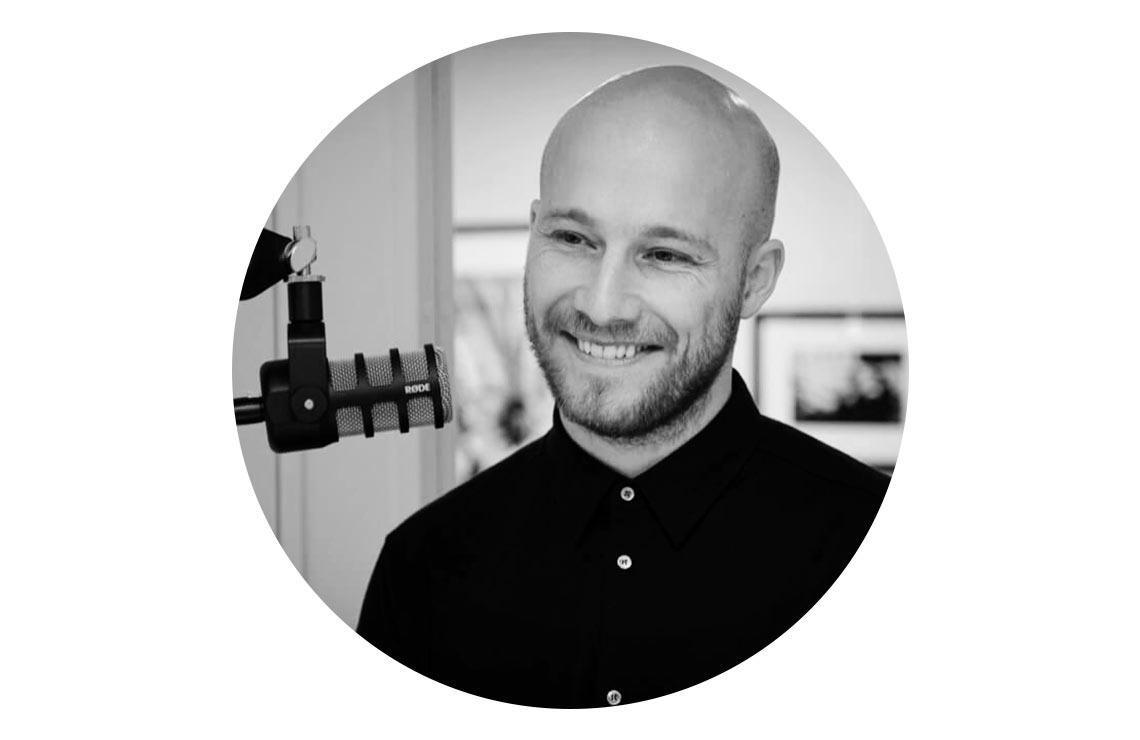
Anders Grimstad
Head of Tech Experiments
Years in Schibsted: Almost 5

Zuzanna Zygadlo-Stenberg
Technology Strategy Lead
Years in Schibsted: 1.5
Meet our people: From trash to bargain
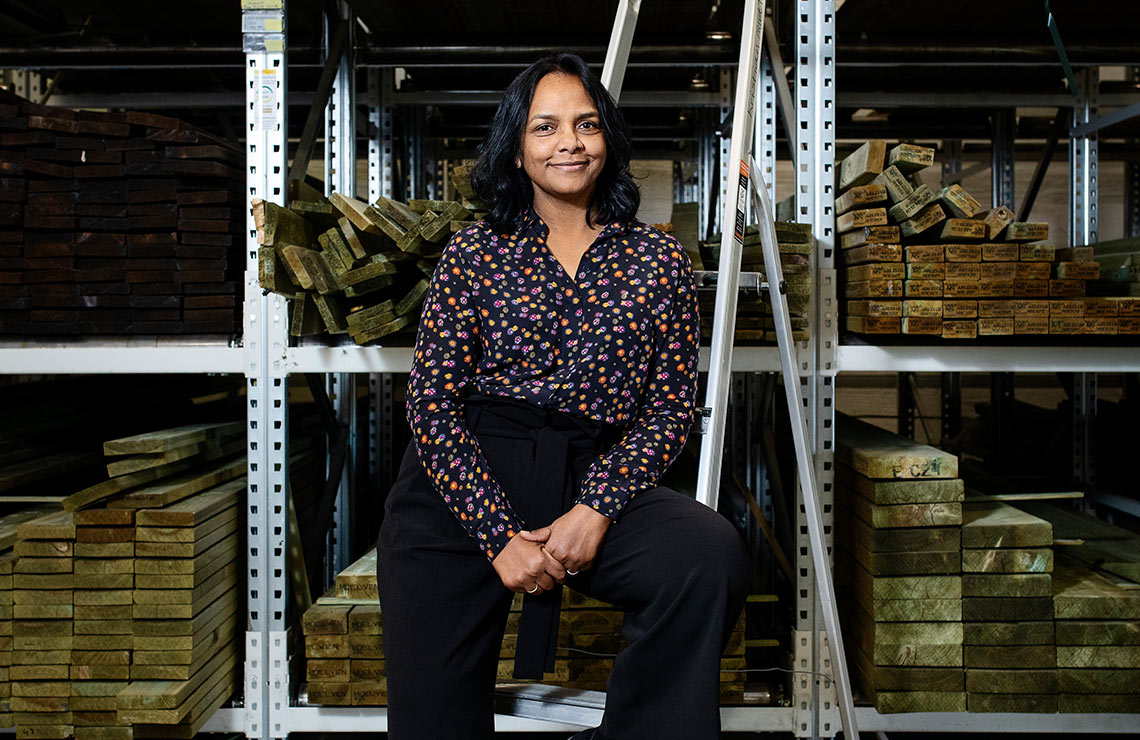
Meet our people
Anjali Bhatnagar started Tørn to make use of hardware overstock, Anton Assarsson creates real value for advertisers and Therese Cappelen is rethinking periods. Get to know some of our people.
From trash to bargain
Did you know that in Norway alone, building materials with a market value of four billion NOK end up in long term storage and ultimately get thrown away? The situation is similar across Scandinavia.
We’re talking about fully functional goods and tools that have been replaced by newer models or were in stock only for a season. When Anjali Bhatnagar heard about this, she knew that it would be her next project. After shutting down a previous project – a marketplace for second-hand fashion, which didn’t fly, she already had a platform and contact with investors, Schibsted being one.
“I realized there are buyers who would be very interested in these supplies, but the stores do not have access to them.”
That’s how Tørn was born, a marketplace for hardware overstock, where you can buy everything from nails to floors and bathroom equipment for a really nice price, and at the same time save the planet from some unnecessary waste. But the key to success is convenience.
“Tørn makes it easier for the stores to sell rather than throw away the goods”, explains Anjali.
“It’s very simple for the sellers to automatically get their goods up on our platform. In return, they get ready orders and even a shipping label from Tørn. We deal with the payment and everything else.”
So far, Tørn has been off to a good start. In only a year, 120 stores have come onboard and another 250 are on their way in Norway – and next year a pilot will be launched in Sweden.
“I have worked with both technology and user centred design in the past, and I strongly believe that both disciplines are relevant tools to create commercially successful and sustainable solutions for real problems.”
Anjali Bhatnagar
CEO and Founder Tørn
Schibsted invested: May 2021

“I really enjoy the creative process”
In 2021, more than 400 million Swedish krona was spent on native advertising in Sweden. There’s no question that a good story is valuable. Anton Assarsson is Head of Editorial for Tailor Made Solutions in Schibsted’s Brand Studio in Stockholm, and he knows that the market has even greater potential to grow.
“Advertisers from all around the world see the potential in getting their message across in a storytelling-fashion on Schibsted’s platforms. And they understand that the readers and viewers appreciate it.”
The key to a successful campaign for him and his team is to take an editorial approach when creating content, and Anton, a former journalist, knows how to do just that.
“I really enjoy the creative process and that I get to use my experience as a journalist to create value for our customers.”
He emphasises that the distinction between commercial and editorial content is critical – and that it should always be obvious to the users that what they are reading is advertising.
“But what is great is that if the storytelling and content are good enough – the readers will choose it, and appreciate it, regardless.”
Anton Assarsson
Head of Editorial, Schibsted Tailor Made Solutions
Years in Schibsted: 8

Syd is rethinking periods
It all started with an interest in how companies can make a difference. Now Syd offers subscriptions for organic tampons and pads – and support to girls on the Ivory Cost.
“I was tired of menstrual products brands being stuck in the past. No one seemed to care about the whole experience,” says Therese Cappelen, one of three founders behind Syd.
A starting point was when she met her co-founders, Adriano Sannelli and Christian Nordenborg. They shared the belief that businesses should also do good.
So, when you subscribe to Syd’s products, you are supporting girls on the Ivory Cost. For every product sold, a percentage of the profit is donated to make sure that they have access to safe toilets with running water and period care. Syd is cooperating with Save the Children to build toilet facilities at six schools in the country.
As a designer, Therese reacted to the excessively pink packaging and branding of menstrual products, which are often decorated with flowers and animal prints. Syd’s blood red and the letters in its name are placed to symbolize a vagina.
“Periods are still associated with a sense of shame and hush-hush. We want to change that,” says Therese.
Therese Cappelen
Co-founder Syd
Schibsted invested: September 2021
Telling the Schibsted story

Telling the Schibsted story
For years Schibsted has been the hidden parent company behind a portfolio of some of the most appreciated companies in the Nordics. Today, Schibsted, a brand that has existed for over 180 years, is also growing into an identity of its own.
Schibsted’s history goes back all the way to 1839 and Christian Schibsted’s printing business. Ever since it’s been a story of transformation, entrepreneurship and carrying the torch for independent media and freedom of speech.
But although it’s a strong and compelling story, it’s not very well-known – for a long time Schibsted has been an unknown owner behind a portfolio of some of the strongest brands in the Nordics. It has always been, and still is, our brands that should shine the brightest. However, the need for a stronger parent brand has gradually risen.
We are becoming consumer-facing
There are many reasons for this. Employer branding and the war for talent requires a clear identity. How do we attract the best people if they don’t know who we are and what we aspire to be?
Promising startups and companies that Schibsted would like to invest in, will want a partner they understand, respect and believe they can build a long-term relationship with.
And, Schibsted is also becoming a consumer-facing brand of its own, with our login and identity service Schibsted account. Owning the data of customers interacting with our companies, also means the need to build trust in Schibsted. And trust demands a certain level of knowledge and understanding of who we are.
That said, in order to build a strong brand, you need to have the right tools in place, and understand that strategy and branding are two sides of the same coin. That’s why, in the spring of 2021, we launched our overarching strategy and identity, Schibsted Future State. This defines what Schibsted is and should aim to be, what sets us apart as a company and why we exist. It’s what we want Schibsted to be, in the hearts and minds of people connecting with us.
Our three main pillars
These are the three main pillars explaining who we are – our mission, our vision and our character:
What do we do? Empower people in their daily lives.
Why do we do it? To uphold a society built on trust and transparency.
How do we do it? As a fearless force for change.
To express what is true and important all across Schibsted we have also created a set of uniting principles. They say something about how we approach business across our family of brands and how we work together. Not every principle will seem relevant all the time, but they set the standard Schibsted brands should aspire to, and codes of conduct that no brand strategy or value should violate.
- We take leading positions
- We create exceptional user value by sharing data and capabilities
- We champion a responsible internet
- We are more than the sum of our parts
- We think big and long term
- We know the power of local.
- We are accountable
- We are entrepreneurial
A family story
Schibsted Future State does not replace our brands’ individual mission, strategy or value. Rather, it serves to complement them. However, it says something about our family, the history and legacy that connect us, and the future we want to create together. What we do want, is for people to understand Schibsted as the parent that orchestrates our family of brands.
It is our ambition, though it may take some time, that most people working in Schibsted will easily be able to sum up what our strategy is. When all our business decisions are aligned with our strategy, when there’s a clear coherency and consistency in how we tell our story to everyone out there; from potential employees, to customers travelling through our digital services and channels that’s when people can start to really evaluate how loveable Schibsted as a brand really is.

Nathalie Kåvin
Head of External Communications & Brand Management
Years in Schibsted: 3.5
Build a brand that gets into people’s heads

Build a brand that gets into people’s heads
The marketing discipline has, of late, been obsessed with short-term performance marketing. It seems that many of us have forgotten the true value of being a brand that people really love. Hanne Hollstedt, Head of Marketing in Schibsted Ventures Norway, is seeing signs of change.
Today, many companies are almost blinded by the urge to gather enough data. It’s all about hitting that exact moment when your customers make a purchase decision – all to reach a certain sales target. Yes, of course tracking, gathering and analysis of data is important. But what happened to building a brand that customers want to buy in the first place?
A common definition of a brand is “a name with the power to influence”, according to reputed brand expert Jean-Noël Kapferer. But creating a brand that evokes love and trust, as well as the power to influence, is rarely at the centre of strategic discussions.
A gut feeling
All too often, brand strategy is left to the marketing team, and the marketing team is measured on short-term conversions. The strategic discussion centres around product, people, technology and KPIs related to revenue growth and costs. It’s tangible and easy to measure.
Honestly, if you ask yourself whether a financially strong competitor would be able to copy your product, technology, people or customer journey, the answer will in most cases be “yes”. But if you ask the same question about your company’s name or brand, and you can answer “no”, then you know you’ve got a winner.
One of a company’s most important assets is the space they occupy in people’s minds; the gut feeling and willingness to pay that they immediately stimulate –and the possibilities their name gives for future growth and opportunities. The sum of all choices that tip things in your favour – now that’s your brand making a difference.
Finn.no is by far the most popular marketplace in Norway, behind which is a large pool of talented developers, sales personnel and product owners. Finn has developed a strong company culture and substantial financial resources. However, all these assets could be copied, in one way or another.
Essentially, there is not a single unique element that you can’t copy or recreate.
However, try to occupy the same space in the heads of the Norwegians that the Finn brand does. That’s hard …really hard. That’s what’s called the performance of the brand.
The short-termism is to blame
So why isn’t the brand a central part of the strategy in all companies?
I think today’s short-termism is partly to blame, but also that the idea of brand is so complicated. To quote Jeremy Bullmore: “Brands are fiendishly complicated, elusive, slippery, half-real, half-virtual things. When CEOs try to think about brands, their brains hurt.”
From an investor perspective, the value of a company is not just the tech stack, production sites or current customer base.It’s whether they have a name with the power to influence future growth. This value lies in the brand. A well-used example, but nevertheless one of the world’s best, is “The Company that shall not be mentioned” who sells 15 percent of all devices in the smartphone category but keeps 66 percent of the global profit pool. No competitor has yet been able to take more than a tiny bite of that apple.
As for marketing, if you need to be right in front of people’s faces to be remembered and chosen, that represents a consistent and high cost. It’s like being trapped in a hamster wheel. Building a brand, on the other hand, is a sustainable, long-term investment.
Recent research shows a not surprising correlation between share of brand searches in a category and the brand’s market share (Les Binet 2020). This means that you also must focus on what triggers customers to search for your specific brand in the first place, rather than put all your focus on the generic searches in your category.
The future winners will be the ones who are able to create a name that increases the chances of customers choosing you over the competition, attracting more customers, at a lower cost, who are happy to pay a little extra for you. They will deliver more revenue, profit, and growth, more efficiently, and ultimately, generate more shareholder value.
The value proposition is crucial
The start-ups that we in Schibsted Ventures meet obviously don’t represent strong brands…yet. They are simply too immature. However, it is possible to identify companies that might have the potential to become powerful brands.
I would argue that start-ups that have a clear value proposition and are able to articulate that through both internal actions and external communication have a head start on their journey to becoming a strong brand. If you know why the users and customers should choose, trust and maybe even love you, you have come a very long way.
This might seem simple and intuitive, but it’s not. Very often a company starts out with some kind of solution that they more or less accidentally developed, without a clear vision of the actual value proposition. That might turn out well, but it also might result in blinding frustration no matter how advanced or clever your performance marketing strategies.
If you take a step back and try to figure out the essence of the market that your start-up is targeting, and what the actual drivers and barriers are, then you have taken the first step to creating a brand that makes a difference – a brand that is your performance.

Hanne Hollstedt
Head of Marketing, Schibsted Ventures Norway
Years in Schibsted: 2.5
For your ears only – the rise of social audio

For your ears only – the rise of social audio
With more than two million shows and in excess of 48 million episodes online (as of April 2021), podcasts are still growing in popularity. The global pandemic also gave rise to a new trend in the audio space: social audio.
Everyone from major publishers to smaller creators are creating podcasts, and the topics are as varied as their hosts. While it’s difficult to find statistics for podcast listening globally, more than 60 percent of American adults from age 18 to 34 listen to podcasts monthly. It’s projected to be a 1 billion USD industry by the end of this year.
Social audio
Still, there’s an even newer phenomenon that has emerged on the audio scene in the last year or so. It’s called social audio. It started when Clubhouse hit the scene in 2020, and it gained a lot of traction as the Covid-19 pandemic had people all over the world sitting at home, starved for human connection. The Clubhouse app was, at the time, invitation-only, growing slowly but steadily over time. But in the wake of its rising popularity, other platforms saw an opportunity.
Platforms that already had significant audiences, such as Twitter, Facebook and Spotify, threw their hats into the ring and created their own versions of places for people to connect via audio. Even Amazon is reportedly creating a live audio business. In gaming, voice chat has been huge for decades, allowing players to talk in-game, and that phenomenon has been extended to external platforms like Discord, which has become more of an all-around voice chat and streaming platform.
As to why audio has become so popular across channels, tech analyst and investor Jeremiah Owyang describes it as a Goldilocks medium. “It’s not as impersonal as text but also not as invasive as video — something particularly important for the Zoom-fatigued user”, he says. There’s also a case to be made for audio as a more human and authentic medium.
Important source of income
For publishers and advertisers, the growing audio space has a lot to offer. Subscription-based products have become some of the most important sources of revenue for publishers, whether paid for by users or advertisers. Audio can also be a way to create stronger connections with your audience and to humanise your brand.
As social audio and, perhaps most notably, podcasts grow, advertisers will follow suit. Global podcast ad spend is predicted to double, reaching 1.6 billion USD in 2022, according to a study by the World Advertising Research Centre (WARC). Another study, the Super Listeners 2021 report by Edison Research, shows that podcast advertisements are the most recalled type of ad, with 86 percent of respondents saying they remember seeing or hearing an ad.
For Schibsted, podcasts are an important part of its core business, as shown by the company’s increased stake in the podcast company Podme. The audio space is especially important in the Nordics, with Sweden being one of the world leaders in podcast listening, according to the German market and consumer data firm Statista. The Nordics have a long history of qualitative audio media, with global tech giants, including Spotify and Acast, originating in Sweden.
Although the audio climate was disrupted at the start of the pandemic, especially with podcasting being a favoured commuting pastime, it didn’t take the expected downturn, but instead came out of the crisis on top. And for everyone from listeners to publishers and marketers, it looks like it’ll keep on climbing.

Camilla Buch
Advisor Editorial Content
Years in Schibsted: 1.5
There’s no going back to brick and mortar
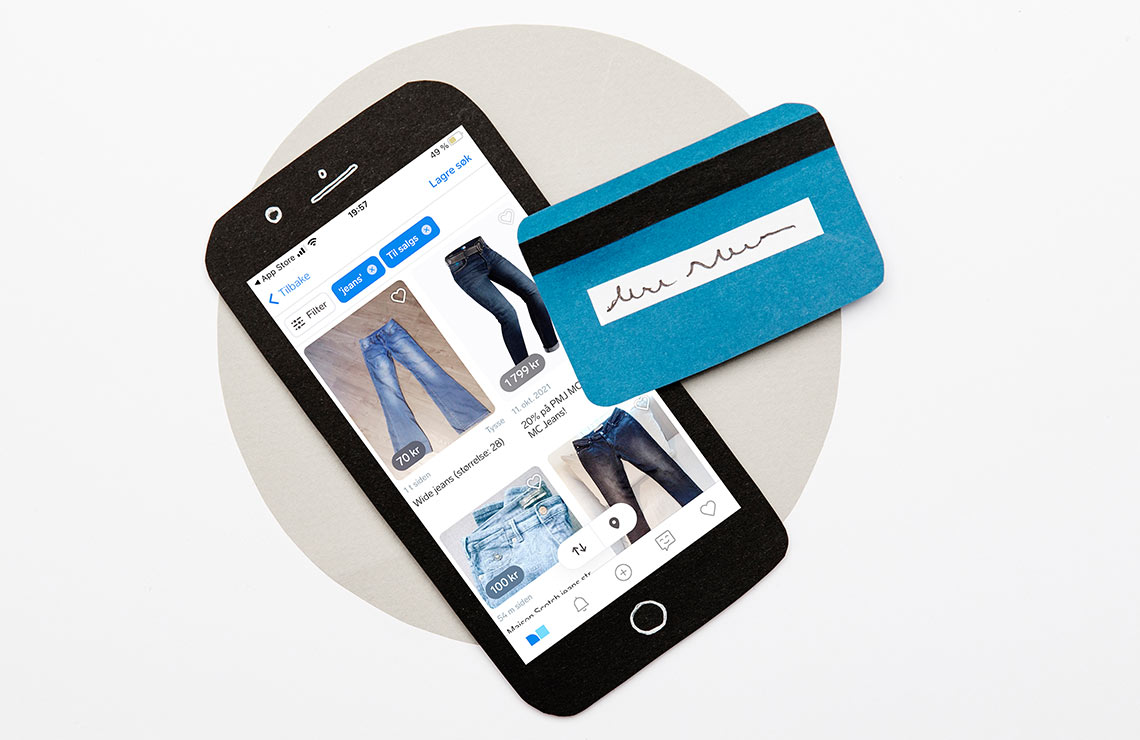
There’s no going back to brick and mortar
The pandemic has permanently changed how we shop, bringing e-commerce firmly into the mainstream. Retail behaviours that started as a Covid-19 necessity will continue even after the long-awaited return to “normalcy”.
The simple explanation for this shift is that convenience always wins, and the pandemic awakened shoppers to a world of seamless deliveries and curb side pick-ups from their favourite big-box retailers. Beyond that, the evolution of shopping has also opened the door for consumers to trade traditional brand loyalties in exchange for the best price, the most eco-friendly or the most socially conscious.
“You’re not going to see a full rollback when it comes to e-commerce penetration”, says Hana Abaza, Shopify Plus’ Global Director of Marketing.
“Some people will actually shift into buying certain things online, and they’ll keep doing it.”
A fierce fight
Given that there’s no going back, let’s look ahead and focus on how e-commerce will continue evolving into a more interactive, virtual and data-driven experience for shoppers, with an emphasis on mobile and social. Driving that innovation in e-commerce is a playing field more competitive than ever. Online customers have quickly flocked to the retailers who could offer a best-in-class user experiences, fluid logistics or frictionless payments. While market leaders such as Amazon continue to shift billions in gross merchandise value (GMV), the fight for a share of the customer wallet remains fierce among the long tail of both old and new players in the online shopping space.
In September 2021, the mobile analytics firm App Annie concluded that the pandemic accelerated e-commerce growth by ten years. Mobile shopping activity spiked worldwide in 2020, and the amount of time spent in shopping apps grew by almost 50 percent. Better mobile experiences have also led to bigger shopping carts, with the average mobile shopping spend rising by 22 percent to 78 USD. Mobile-first retailers are continually rolling out tactics to keep consumers in the app longer, such as games and other interactive elements like chatbots, wish lists and stories.
So, why do we see this defining the next generation of online commerce? Mobile penetration rates are continuing to grow, particularly in previously underdeveloped regions including South America and Southeast Asia. To note: Indonesia experienced an 87 percent rise in mobile shopping activity, the largest of any country in App Annie’s report. Secondly, Gen Z’s rise as an economic engine will continue to power mobile commerce. After all, this is a generation where 95 percent own a smartphone and are willing to pay a premium for uniqueness and sustainability.
A way to convert sales
As e-commerce develops in the 2020s, retailers will figure out a way to better replicate and refine the in-store experience. What started as a necessity often driven by social distancing limitations has now become a way to convert sales of even high touch items like automobiles, as customers can avoid a trip to the shop or showroom. Whether it’s virtual fitting rooms or expanded augmented reality, “try before you buy”-tech is one step towards combining the physical and virtual. Customers want to know how that sofa table looks in their living room, or whether the luxury bag matches the rest of their wardrobe. Part of that is also driven by retailers’ needs to save on expensive returns – which could have a considerable climate impact as well.
Online retailers have also made great strides in providing a more personalised space for shoppers. Search-led shopping is on the way out, as the focus shifts to directing users toward custom product recommendations. Discovery shopping appeals to the customer base who don’t know what they want. Alibaba has perfected the art of qiān rén qiān miàn (千人千面, which translates to “a thousand people, a thousand faces”), which displays personal storefronts and treats retail like content, complete with an infinite-scroll option much like you see on social media. It has the same effect as the “bottomless bowl”, a psychological experiment that led to respondents eating 73 percent more soup from their endless serving. Just like social media feeds, these recommendations are built on huge tranches of data and ever-evolving AI technology to make them more relevant, more compelling and more able to convert to a sale.
A November 2020 survey by Bazaar voice revealed that more than one in three shoppers made a purchase on social media last year. While Facebook is the leader with its established Marketplace, Instagram and TikTok have ramped up the integration of shopping into their user experiences, both through paid ads as well as by highlighting shoppable products in user-generated content. Just as word of mouth or a friend’s recommendation can push you to make a purchase offline, consumers too can be compelled by seeing the products bought by their online social connections. Unsurprisingly, influencers who make their living on social media platforms are among the first to partner with brands for more integrated social shopping content.
With all the competition from mobile-focused and “bricks and clicks”, the one area where retailers can’t afford to slip up is at checkout. Few things are more frustrating for retailers than pulling a customer all the way through the sales funnel, only to lose them due to friction at the point of payment. To reduce hassle, some retailers have even done away with carts and let customers buy directly from the product page.
Remove friction is key
The key is to remove friction. That’s why we’ll see one-tap checkouts become the norm in e-commerce, supported by “buy now, pay later” plans. Those flexible payment plans, popularised by Sweden’s Klarna, have, over the course of the pandemic, reshaped how we pay for purchases. So much so that a recent McKinsey survey revealed that 60 percent of respondents planned to use some sort of financing option at purchase within the next twelve months.
Live commerce has been a staple of online retail in China ever since Alibaba first debuted the technology in 2016 at Taobao Live. Jumping ahead to 2020, McKinsey reported that more than two-thirds of Chinese shoppers had purchased a product via livestream. Even with the country’s signature shopping event – Singles Day – setting records in terms of sales (115 billion USD in 2020), livestreaming remained a mystery to Westerners. The pandemic changed that, as first-movers saw live commerce to be a low-risk bet to differentiate themselves. Bigger players such as Amazon and Walmart weren’t far behind, and social media followed in lockstep, with Facebook launching Instagram Live as part of its strategic pivot to more shoppable content.
Brands have figured out that live commerce helps blur the line between shopping and entertainment, an important factor for success in tomorrow’s marketplace. With influencers performing for their audiences, demonstrating products and fielding questions, buyers can rediscover the human interaction that went missing during the pandemic.
Thanks to their expansive assortments, refined logistics and ability to collect comprehensive customer data, the mega online retailers will have a decided advantage in the online marketplaces of tomorrow. The same goes for those nimbler operations that lean heavily into mobile, social, and niche communities. Yet, as significant as the trend toward e-commerce has been, it’s still relatively early in its evolution, with plenty of market share yet to be claimed across industries.

Jeremy Cothran
Former Editor, Schibsted Daily
Years in Schibsted: 1.5
Join the disruptive marathon

Join the disruptive marathon
Technology and disruptive marketplaces will play a key role in building a more sustainable future. But sustainability still isn’t the main driver for users to change behaviour – convenience and competitive prices remain crucial, says Christian Horn Hanssen, Lead Investment Manager at Schibsted Ventures.
According to latest projections from the UN, the global population could grow to around 8.5 billion in 2030, and 9.7 billion in 2050. That means that the equivalent of almost three planets are potentially needed to provide the necessary natural resources to sustain our current lifestyles.
Furthermore, the UN’s Inter govern mental Panel on Climate Change (IPCC) issued a report in August 2021, stating that “human activity is changing the climate in unprecedented and sometimes irreversible ways”. It has never been clearer that we need to change on multiple levels to build a more sustainable future. This will require a huge effort from both businesses and consumers alike, but at the same time, it will also create enormous opportunities for those who manage to act and adapt.

This is how the UN explains what it’s all about: “Sustainable consumption and production are about doing more and better with less. It is about decoupling economic growth from degradation, increasing resource efficiency, and promoting sustainable lifestyles, which in turn could contribute to poverty alleviation and aid the transition towards low-carbon and green economies.”
Tech is a driving force
To achieve this, it’s worth exploring how technology and disruptive marketplaces can serve as driving forces. Over the past two decades we have seen the emergence of disruptive marketplaces and platforms. We have witnessed the television industry being disrupted by Youtube; the traditional hospitality industry being strongly challenged by Airbnb; and physical commerce being threatened by e-commerce, in particular by Amazon, which made it easy for non-technical people to operate their own online stores.
For a marketplace or platform to be disruptive, it must identify either new supply, new demand, or both – targeting individuals or businesses unable to profitably produce or consume goods and services in incumbent channels. The most powerful disruptive marketplaces are often those that simultaneously connect non-consumers with non-producers. Airbnb exemplifies this, case in point when it unlocked people’s homes (non-producers) ten years ago to a new set of users (non-consumers). The result is that we now see a new generation of niche, disruptive marketplaces continually emerging, ones that are focused on increasing resource efficiency and promoting sustainable lifestyles.
The fast growing American company Hipcamp is a great example of this. Hipcamp was founded in San Francisco in 2013. It is an online marketplace that offers outdoor stays and camping experiences via its website and mobile app. Private landowners, for the most part, list campsites, glamp sites, RV spaces as well as cabins, for users to discover and reserve based on listing type, location, landscape, activities offered and amenities. Hipcamp’s mission is to unlock access to private land, creating new places for people to experience the great outdoors and camp, much in the same way Airbnb did. Not only does its marketplace drastically increase the supply, but it also lowers the threshold for booking an outdoor stay for those who previously did not consider this to be a holiday option at all.
Glamping has gone from being niche to mainstream, driven by consumers who seek safe, local holiday experiences.
Hipcamp has, not surprisingly, experienced a surge in bookings during Covid-19. Glamping has gone from being niche to mainstream, driven by consumers who seek safe, local holiday experiences, which has slowly changed user habits. Even though few believe that Hipcamp will be a substitute to the traditional hospitality industry, many believe it will play a central role in offering a sustainable way to spend your holiday – unlocking new, local destinations that may lead to less long-distance travel.
New disruptive models are also challenging our ways when it comes to clothing. The textile industry is the world’s second-worst polluter, both in terms of production and waste. The EU estimates that a staggering 10 percent of global greenhouse gas emissions are caused by the production of clothing and footwear. One of the biggest problems is the vast overproduction and amount of unsold goods. New York based Rent the Runway (RTR) has set out to solve this problem. Founded in 2009, RTR allows customers (mostly Gen Z) to rent clothes and purchase second-hand merchandise from more than 750 designer brands.
Preventing supply from being burnt
In creating a niche, rental marketplace, RTR has built a platform in which brands’ unsold items can be worn by multiple customers over time, increasing longevity but also preventing some of the overproduction supply from being burned.
On top of all that, it is slowly changing user behaviours. RTR reports that 89 percent of its members say they buy fewer clothes than they did before joining RTR, and that 83 percent have consumed less “fast fashion” since joining. The fashion rental market is now projected to be valued at two billion USD by 2025, and rumour has it that RTR will be going public within 2021.
In 2019, Schibsted Ventures invested in Bookis, a fast-growing Norwegian marketplace for new and used books. Bookis has grown into the largest online bookstore in Norway, with almost 300,000 users and more than one million titles. Much of its success can be attributed to lowering the threshold for buying and selling used books by making it very easy for users to upload books for sale and integrating payments and logistics (a nimble C2C solution) through its platform. This has led to the creation of a whole new market: the “almost new, slightly used” (typically read once) book market.
By creating an effective way of buying used books (convenience) and enabling readers to also purchase newly published but slightly used books at a 40 percent discount, readers are incentivised to buy from Bookis rather than buy new. By offering royalties to authors for every second-hand transaction, it also gains their support. The ultimate effect being that it creates a new, disruptive marketplace with demand from what used to be non-producers – people with a library at home – with the supply of what used to be non-consumers – people who usually didn’t buy new, hardcover books but rather waited for the paperback edition or went to the public library (Read more about Bookis on pages 102–105).
Superior convenience is a must
I truly believe that disruptive marketplaces can be a driving force in building a more sustainable future, but as with ordinary marketplaces, there are some key elements that need to be in place to change user behaviour. New disruptive marketplaces must deliver superior convenience and be competitive on price. Studies have shown that even though people are more aware, sustainability alone is not a strong enough driver in itself for most users. For Bookis, it’s about the combination of convenience and price, not only the fact that it is a sustainable alternative.
It is also crucial to create a value proposition that satisfies both the demand and supply side of the marketplace. RTR creates a solution and an alternative business model for the overproduction of the clothing industry. In addition, it lowers the threshold for users to rent instead of buy new clothes by providing an attractive value proposition (price, convenience, new supply). The result is a win-win situation for both sides of the marketplace, and it has the potential to alter user and business behaviours over time.
I believe that the shift we are going through right now is a marathon, not a sprint. Changing user behaviour will take time and require multiple alterations. That’s why it is so important that we take part in driving these changes. Great opportunity awaits those who act and adapt today!

Christian Horn Hanssen
Senior Investment Manager Financial Services & Venture
Years in Schibsted: 13
The crumbling future of the cookie

The crumbling future of the cookie
As privacy regulations and tech giants throw a spanner in third-party cookies’ advertising works, publishers seek new ways to monetise their content.
The cookie was born out of the mind of Netscape engineer Lou Montulli in 1994, as a tool to help websites remember user data. And cookies still perform this function to this day, allowing users to forget complicated passwords and what they put in their shopping cart the night before. However, it only took one year before Montulli’s creation was used for targeting and tracking users across the internet, much to the delight of the advertising world. Adtech firm Doubleclick was founded in 1995, quickly becoming the pioneers of ad targeting online. Google acquired the company in 2008, and the rest is history.
Big Tech in the lead
In recent years, users have become more aware of how companies are following their every click. Who hasn’t briefly entertained the thought of buying a new pair of shoes only to be followed by advertisements across platforms for the following month? The growing fear of what ad tracking means for online privacy has led lawmakers to pass legislation that protects users, Europe’s GDPR laws being a primary example. But most effective measure in terms of stopping the third-party cookies in their tracks has been the work of Big Tech.
While smaller browsers including Firefox and Safari blocked third-party cookies back in 2019 and 2020, respectively, it wasn’t until Apple and Google announced their intent to do so that the world of publishing and advertising quickly realised the need to change. While there is, of course, widespread skepticism about tech giants like Google and Apple having the mandate to enact changes that will disrupt entire industries, the change is already taking effect.
Apple has already started requiring its apps to request explicit consent to track users across devices. Google is working to create an alternative solution to ad tracking. What that alternative will look like is indeterminate at the time of writing. Google’s first plan was to implement FLOC (Federated Learning of Cohorts), which would assign opaque numerical cohort IDs to websites and people. After facing backlash from the advertising industry, Google’s looking into alternatives, such as assigning topic categories to users instead. But no matter the solution Google selects, the result will be more or less the same: publishers and advertisers will have to change the way they work.
Many different solutions will come
Some publishers have taken the matter into their own hands. In 2008, Schibsted launched its own first-party data program for direct-sold ads, a strategy New York Times also adopted in 2020. Vox Media launched Concert Ad Manager, a self-service tool enabling brands to create and deploy advertising campaigns across Concert, the publisher-led marketplace it co-founded in 2016. Other publishers have seen success in going back to older strategies like contextual advertising. Schibsted is one such publisher, as it will increase its focus on first-party data and contextual advertising.
Furthermore, Schibsted has launched Schibsted Match, a type of targeted advertising where advertisers can deliver customised messages directly to their customers on Schibsted’s websites.
We expect to see many different solutions contribute to the death of the cookie; some publishers will likely simply follow the lead of Google, while others will have more success in creating their own solutions. The past two years have also proved to many publishers that they will have more success by focusing on subscriptions rather than ads, even though subscription growth has plateaued somewhat following the surge during the pandemic. In the end, it’s the publishers who invest in diversifying their revenue streams who will most likely come out on top, no matter how the cookie-free future of advertising pans out.

Camilla Buch
Advisor Editorial Content
Years in Schibsted: 1.5
Finn changed the history of Schibsted

Finn changed the history of Schibsted
Creating the Norwegian marketplace Finn was a milestone in Schibsted’s history. The idea challenged the existing businesses within the newspapers – but it turned out to be an international success story.
In the late 1990s the advertising revenue of newspapers crashed. Data and the internet were here to stay, and paper ads were no longer what they once were. The newspapers had to do something. Five major Schibsted newspapers in Norway put their best people on the job to find a solution that would secure revenue from classified ads in the future. The solution was – a web site with pictures of the newspaper ads! (vis@visen can be translated to: Show the newsp@pers).
The ads were not searchable, so it was really just the old newspaper ads on a screen instead of on paper. It was not a success.
But the owners did not give up, they realized that they needed a different approach. The ads had to be digitized, and it had to happen quickly. There were several competitors who had already launched digital solutions, so it was not about being first anymore. It was about being the best.

Terje Seljeseth, IT manager at Aftenposten, was given the task. He gathered a small team that gave the new service the name Finn. Finn was formally established as a separate company in 1999, but officially launched in March 2000, with great fanfare in central Oslo. Remember that this was early in the age of the internet – so many people shook their heads, and there was even a public debate about the future of the internet at the University of Oslo!
A lot of those who worked in the newspapers were skeptical and feared that the newspapers’ investments in internet advertisements would make them unemployed. Many also had little faith in the internet in general.
But the founders decided to hire people who were specialists in real estate, jobs and cars, along with highly competent people from the IT industry.
The mantra was ”We are all sales people. Launch and learn. Embrace change”. These keywords are still used and are a strong base for the internal culture.
Thinking differently
I worked in the advertising department at Aftenposten, and was employed in Finn in August 2000 to take care of the customers. There were only 10–15 people in the entire company, so everyone had to contribute.
We knew that in order to succeed, we had to do better than our competitors, and think differently than the newspapers. For example, we wanted the real estate ads to have many nice photos. But almost no one had cameras that could take digital photos. Therefore, digital cameras were purchased, we gave them to our customers, and we taught them how to use them.
We spent a lot of time teaching people to post their ad themselves, and we also received photos that we scanned and posted on the ads. On several occasions we traveled to our most valuable customers and sat down with them to teach them to be self-sufficient.
Not all of the customers were equally enthusiastic.
Real estate agents and car dealers were afraid to lose market share and did not want private individuals to be allowed to place ads. Fortunately, no one listened to them!
Finn quickly became popular and grew at the same time as most people got a PC and internet at home, so the timing was perfect.
Finn has done well, even during economic downturns, it has grown steadily. In bad times people sell houses and cars, and in good times they switch more often – and in both cases there is a need for ads.
Already after three to four years the company was making good money. In 2003, Torget (general merchandise) was launched, and in 2006 came Reise, the travel vertical.
In 2006, Finn had 548,332 ads on Torget, in 2019 there were more than nine million new ads, and we expect to reach ten million in 2020. We had cake for every million new page views. For a time, we ate cake every week, and we had to buy fruit and vitamins to balance our diet. I still blame those celebrations for all my extra pounds.
The focus has always been on the users’ experience
For me and my team at customer support, the focus has always been on the users’ experience. All feedback is taken seriously, and the teams are doing their part to continuously improve the user experience.
Finn’s marketing strategy has always been to be very down to earth, with a twinkle in the eye – and customer support are using the same tone of voice. Since Schibsted also had newspapers in Sweden it was important to secure that market too. So, in 2003 Schibsted bought Blocket, which then became a template for the group’s future classifieds websites. Schibsted was one of the first players to follow a global online classifieds strategy and made an impressive international expansion. In early 2019, the company owned classified marketplaces in more than 20 countries.
In May 2019, it was announced that Schibsted had spun off the international marketplaces into a new company – Adevinta. Today we know that the split has led to even more marketplaces worldwide, and so far it has peaked with the purchase of eBay’s classified sites in summer 2020. Finn is now a part of Nordic Marketplaces in Schibsted, along with Blocket in Sweden, and Tori and Oikotie in Finland.
So, in a sense Finn was the beginning of an incredible journey for the company itself, for Schibsted, but also for society. The services provided by all these sites also help people to make sustainable choices, since trading second-hand goods is a part of a circular economy and reduces our environmental footprint.
Innovation and growth is key
Since Finn was an innovation in itself, innovation lies in the company’s genes, and experimentation is a part of everyday life. Much has changed over the years, some marketplaces have come and gone, some have been successful, and some have failed. The old mantra ”Launch and Learn” is still in the walls.
Usability is another keyword. All feedback from users and customers is constantly used to continuously improve the experience. Today, almost 30 people work with user experience and service design.
The cultural values ”Sult, Humør, Takhøyde, Presisjon” (Drive, Spirit, Tolerance, Precision) have been there all the way, and by living these values both internally and externally, Finn has a unique and strong culture. It is also one of the most known brands in Norway.
As in all other industries, Finn must also change over time as both technology and users’ expectations are changing. We’re now starting the journey to become the next generation marketplace, and we will always continue to help people make smart choices for themselves and society. And we will never stop focusing on innovation and growth.

Anne Sandvin
Internal Communication, Finn
Years in Schibsted
22
What I’ve missed the most during the Corona crisis
Social interaction with my colleagues
An inspiring experience will attract Gen Z

An inspiring experience will attract Gen Z
Gen Z are accustomed to defining their own tastes, trends, and values. Most of their screen time is spent inside the big social media apps, where new shopping habits, ways of learning, and trends are emerging. Anniken Ore Larssen is part of a team that is investigating how Finn can meet their needs.
Since January 2020, I’ve been working with a small team at Finn to create a new marketplace experience tailored to the needs of Gen Z. With this we hope to meet Gen Z’s need for inspiration, creativity, and speed. The result is a separate app, launched as an open beta this fall, which gives us the opportunity to iterate and learn fast without annoying Finn’s usual users.
And there is a lot to learn.
As a 28-year old having researched Gen Z for more than a year, I have only one conclusion: I’m feeling old. If I was asked to describe them with just one word it would be impatient. Everything seems to move a bit faster with this generation.
The fact that they have grown up with everything digital, social, and app-based has radically increased the pace of scrolling, liking and sharing. I encourage you to observe this next time you sit next to a teenager on the bus.
High expectations
Being online ”almost constantly” has not only led to a completely different way of navigating, it has raised Gen Z’s expectations of digital services. This also changes their relationships to peers, brands, and influencers. While it is said that Gen Z’s attention span is only 8.3 seconds (down from 12 for millennials), they are good at filtering out what’s important information. They quickly make decisions about what and whom get their attention and time.
Gen Z also has a different way of expressing themselves versus previous generations. With the rise of stories, snaps and six-second Tik Tok videos, things are moving faster. Not only does the aesthetic seem rawer, as we can see in clothing (think Billie Eilish), and photo editing (or lack thereof), also their message has an impatient, rebellious vibe.
They are vocal about their values, the labels they want you to use, and they will call you out if you do something that doesn’t match their expectations.
You might know the creative sides of Gen Z best through memes, snap filters, and Tik Tok videos. Snapchat even names them the generation of super-creatives, and their own research shows that more than half of respondents engage in what we would call creative activities both online and offline (drawing, making music, taking photos, sowing and redesigning). They are constantly on the lookout for new inspiration and new things to learn.
Self-expression is taken to the next level by launching fashion brands on Instagram, enabled by simple, no-code tools such as Shopify and Wix. It has made it possible for Gen Z to act on trends and to influence what’s cool in completely new ways. We can see it in an array of side hustles and smaller entrepreneurial efforts. As quoted by a Gen Z representative in a video by i-D magazine: ”Everyone has a t-shirt brand nowadays”.
I can imagine that Gen Z’s impatience and creativity will be visible in the job market in a few years, for instance by working several jobs simultaneously. Some will do this for a predictable income, while others will do it to fulfill their creative needs, applying this DIY (do it yourself) mentality to their careers as well.
Finding the best deal
Where consumption habits of previous generations might have been more or less dictated by advertising, Gen Z researches several sources to find the best deal. They consult friends, youtubers, and reviews before making a buying decision that is supported both by their wallet and their values.
Big corporations are trying to capitalize on this, such as through influencer marketing. But more importantly, platforms that were previously meant for inspiration only, are now gradually claiming a larger part of the buying journey. The best example of this is Instagram. I’m sure you’ve seen the white dots on some images, showing price tags when you click on them, or the new shops tab in the explore feed.
So, what are we going to do with all this information about Gen Z? In Schibsted, most of our brands grew up over the last 20 years – just like Gen Z. But it seems that this generation’s expectations are outgrowing us. With all this impatience and all this speed, can we, as a big organization, continue to develop products at our usual pace? This is why we started the Finn project and why we made it into a fast-paced process of testing hypotheses with real users during every two-week sprint. Our main idea is that Finn needs to make a similar journey to what Instagram has made – but the other way around. As just mentioned, Instagram is moving towards transaction. We believe that Finn, which has been a place purely for buying and selling, needs to move towards inspiration.
Therefore, we are looking at ways to combine editorial and marketplace content for a new and inspiring experience. We hope that user behaviour will change from using Finn only when you need something specific, to opening the app just to check what’s new, to be able to discover something you like. We want to make it quick and intuitive to find what you’re looking for and learn how to make sustainable choices.
I’m not going to claim we have found the solution to Gen Z’s needs yet. I believe it is a continuous process of testing and evolving, just like they do.

Anniken Ore Larssen
Product Manager
Years in Schibsted
3
What I’ve missed the most during the Corona crisis
Hugging my grandparents

